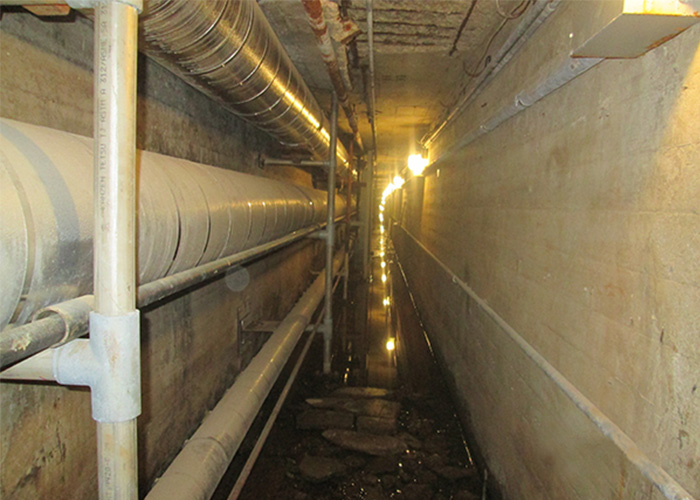
Utility tunnels and vaults have been used to house critical district energy infrastructure for hundreds of years. There are many benefits to having underground utility tunnels and vaults including less impact on pedestrians, traffic, and surrounding aesthetics while improving maintainability and repairs. However, as the saying goes, “out of sight, out of mind”; it’s easy to end up with a system in disrepair or worse yet, develop an unknown hazardous condition to the public.
Since access for repairs to the utilities inside the tunnels and vaults are necessary to keep your district energy system running properly the maintenance on the structures themselves must be a priority to mitigate the development of hazardous conditions, surprise utility shutdowns, emergency expenditures, and shortened life spans.
Here are 5 reasons a tunnel infrastructure assessment program should be a priority.
Track Potential Safety Concerns
The initial assessment will capture the most critical areas in need of repair. If they exist, a temporary shoring system can be developed to alleviate immediate safety concerns. A monitoring program would also be developed to capture the condition and deterioration rate of the structure. This monitoring program will help answer “when” issues need to be addressed and allow for planning cash-flow with the most opportune time to do repairs.
Plan for Future Expenditures
A proper assessment and well executed monitoring program of your utility distribution system will provide you with the information you need to plan and budget for the future. An assessment will help you create capital improvement funding priorities, identify immediate repair needs, outline minor to critical issues with a color-coded map, document issues with photography, and provide a maintenance schedule that can be reviewed and updated on a yearly basis. Over time this will create a historical database of the condition of your utility tunnels, capturing the rate of deterioration and eliminating surprise emergency utility tunnel repair costs.
Coordinate Projects
Because underground infrastructure can be impactful and disruptive at the surface it is important to align campus or community master plans with tunnel improvements and repairs. A tunnel assessment project will determine future needs, allowing the opportunity for tunnel repairs to be performed concurrently with other projects resulting in cost savings and reducing impact on the campus or community. Costs to repair known distressed areas of your utility distribution system can be included in feasibility studies for future building sites.
Reduce Risk of Surprise Expenditures
Once the initial assessment is complete, a schedule for monitoring is established and the information is available to continuously monitor conditions in distribution tunnels. You can be proactive instead of reactive with repairs which helps reduce the risk of surprise expenditures. Identifying tunnel replacements, expansions and repairs before they become an emergency situation reduces disruption to your utility distribution and carefully managed cash flow.
Extend the Life of Your System
Utility tunnels, vaults and other concrete structures have life spans that could exceed 100 years when properly maintained. This life span assumes that typical factors such as water infiltration, steam leaks, ventilation, humidity, structural deterioration, etc. have been controlled. When not properly maintained the service life span of tunnels and vaults can be substantially decreased affecting the overall performance of the utility served.
The question now becomes, can you afford NOT to create a utility tunnel and vault assessment program?

